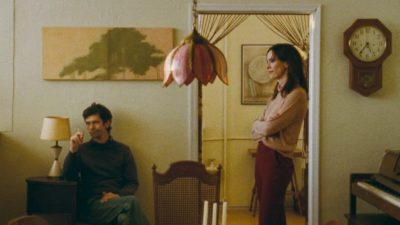Two choreographies by János Feledi, winner of scholarship at the Hungarian Academy of Arts, will be performed on the stage of the Müpa on the 19th of October. One is Orpheus, a play premiered last year, and the other is a new piece called Revenge (Electra). We were talking to János Feledi about the performance.
Orpheus premiered at the same place last year, and also as part of the CAFe Budapest Contemporary Arts Festival.
It was a wonderful experience. It is a great honour but also enormous responsibility to create such a voluminous production at a huge theatre like this. There was an incredible ovation at the sold-out Béla Bartók Concert Hall, which has 1600 seats. I was so surprised behind the scenes that I almost couldn’t go out to bow. And, top of all honours, director Csaba Káel congratulated me personally after the premiere.
Last year you got the request from the Dohnányi Orchestra Budafok for a choreography of Orpheus, written by composer Roland Szentpáli. What did you feel when you first heard the music?
My first meeting with Roland Szentpáli already foreshadowed our successful work together. We liked each other from the first moment on, he showed me the music, I envisioned a world, and he approved it right away. The music is strong and feels hard, with occasional soft melodies.
I imagined a world like Mad Max, so the costumes are quite dark themselves: black coats with rivets, and masks.
Both the composer and conductor Gábor Hollerung gave me free hand for my artistic process. During the rehearsal we felt it would be something exciting and spectacular, and when the orchestra also joined, I experienced the real strength of the piece Orpheus.
A critique mentions that you didn’t have an easy run, having half an hour to “get from the snake and the cypress grove to Orpheus’ final collapse”.
Music starts from the middle and concentrates on the underworld scene, which I liked very much. The composer had a specific concept regarding the structure of the scenes, but he was also open to my ideas. Our only scenery element is a 4-meter-tall chair, symbolizing Orpheus’ world, so the stage and the audience becomes the underworld where my piece is set.
We know what happened to Orpheus, so I did not feel the urgent need to show the prelude, we start from the middle.
So the fusion will be dynamic, lively, erotic, hard, sometimes rock music like, explaining the success of the piece.
You mentioned at a previous occasion that another story was searched to put next to Orpheus, and this is how the idea for Revenge (Electra) came. Why did you feel that Electra and Orpheus fit together?
I was always fascinated by Greek mythology: family relations, complicated linking points, fights for love, battles, wars. The story of Electra was written by many authors already, all of them revolving around revenge. Even today, malice, revenge, family tragedies are present – it is enough to read the news. So we show two extremes of life, a man sacrificing everything for love, and a women driven by revenge.
Your main inspiration were Euripides’ play and Richard Strauss’ opera, Why did you choose these from the endless well of different adaptations?
Both Euripides’ play and Strauss’ opera had a great impact on me. They gave me the founding thought, the click, to create my own version of this myth. In many adaptations, Electra is forgiven, but she is a sinner in my piece. Because she is a murderer for me who uses everyone for her plot, even her brother. My original idea included classical music, but the artistic process led me to a darker, more contemporary atmosphere that fits well with the choreography. I also wanted more spoken parts, but I rejected most of them to avoid too specific messages. I wanted to create something more homogenous.
We can read that in Revenge (Electra), nobody feels and acts the way we know them from other versions of the myth. What can you as choreographer do to reinterpret original characters?
I think characters are basically the same, but we put them in contemporary situations and reframed some moments. This is artistic liberty. Swirling and flowing emotions will be easy to understand and feel. For instance, I created one character from three: a strange being, leading audience through the piece from the beginning, is created from the farmer, the old man, and the messenger. In the original piece, the choir represents the Mycenean virgins, but in my version, it is a projection of Electra’s thoughts, something like a collective consciousness.
Was your job as a choreographer different now, with the stage of Müpa as location?
Of course I have to think and plan differently than in the case of a smaller studio performance. I like to use opportunities of theatre and stage, like the sinker, or moving a big scenery, or the lights. We really have to show something spectacular in a huge space like this, which was an important point when we designed the concept of the piece. I imagined a location for Revenge (Electra) which can be a slaughterhouse or the bottom of a pool, whatever you see in it.
In such a big space and with such a story, pure dance is not enough, so we use tools and design elements that enrich the piece. I think it’s intriguing.
You took part in the editing of music and the design of production and costumes. Was it easier for you to be active in more than one role?
I like to intervene, to create the whole piece from the beginning to the end. It neither makes my job easier or harder but an essential part of the creation process. I am used to have some expertise in many different things and I am also interested in the details connected to the piece.
Feledi Project does not have a company, it searches for artists for different pieces. How did you find currect cooperators?
I have been working with many dancers for a long time, but I also like to bring new talents, energies in a project. I was thinking about it for a long time whom to ask for which role, so that artists really fit to their characters.
A few days are left. In which phase is the piece now?
We have been having the rehearsals for all, the piece works well, but there are still tiny details to clear up. We are practicing movements with the tools and the scenery and change something if needed. We use some liters of liquid, we also have to rehearse this, so that we won’t surprise the audience in the middle of the piece.
Sometimes you come to the stage in pieces of the Feledi Project, sometimes you stay in the background as director and choreographer. What will happen now?
I won’t be member of this new piece. This is better so, a choreographer or director has to stay on the outside to coordinate, see, instruct. It is unfortunate if a choreographer is part of the piece as it is impossible after a while to see it from a more distant perspective, as the own character requires all the concentration.
Whenever I had to play in my own pieces, it was a sad necessity because of the lack of male dancers.
Feledi Project is going to be ten years old soon. Are you satisfied with the last decade?
I think I can feel satisfied with myself and the work I have done. I created a project-based company from nothing, we have two premieres per year and shows every month. The beginnings would not have been possible without the help and support of colleagues and partners. Work, my belief, the trust of colleagues, humility towards my profession, my openness all contributed to me being here today. Also, support from the system of scholarship programs help me as well to create productions and realize my creative ideas.
What are your plans for the near future?
I hope to renew my very first piece and perform it with the original cast for our 10th birthday next year. I also plan to have a photo exhibition from our shows in my favourite place, a coffee shop. I have many ideas and plans for the coming years, I hope they can be realized, just like it happened in the past ten years.
Interview: László Sallai
Translation: Zsófia Hacsek

























Comments